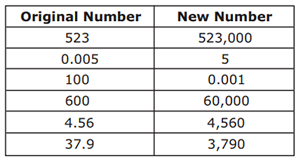Clusters should not be sorted from Major to Supporting and then taught in that order. To do so would strip the coherence of the mathematical ideas and miss the opportunity to enhance the major work of the grade with the supporting clusters.
- Assessment Limits :
Items may contain whole number and decimal place values from millions to thousandths. Items may contain whole number exponents with bases of 10 - Calculator :
No
- Context :
No context
- Test Item #: Sample Item 1
- Question:
What is
 ?
? - Difficulty: N/A
- Type: EE: Equation Editor
- Test Item #: Sample Item 2
- Question:
What is the value of the missing exponent in the equation

- Difficulty: N/A
- Type: EE: Equation Editor
- Test Item #: Sample Item 3
- Question:
Which statement is equivalent to multiplying a number by
 ?
? - Difficulty: N/A
- Type: MC: Multiple Choice
- Test Item #: Sample Item 4
- Question:
When dividing a number by
 , how is the decimal point moved?
, how is the decimal point moved? - Difficulty: N/A
- Type: MC: Multiple Choice
- Test Item #: Sample Item 5
- Question: David multiplies and divides original numbers by powers of 10 to create
new numbers.

Which original numbers were multiplied by
 to create the new numbers?
to create the new numbers? - Difficulty: N/A
- Type: MS: Multiselect
Related Courses
Related Access Points
Related Resources
Formative Assessments
Lesson Plans
Original Student Tutorial
Tutorials
STEM Lessons - Model Eliciting Activity
This MEA asks students to assist Ms. Joy Ride who is creating a virtual TV series about extreme roller coasters. They work together to determine which roller coaster is most extreme and should be featured in the first episode. Students are presented with research of five extreme roller coasters and they must use their math skills to convert units of measurements while learning about force and motion.
Model Eliciting Activities, MEAs, are open-ended, interdisciplinary problem-solving activities that are meant to reveal students’ thinking about the concepts embedded in realistic situations. Click here to learn more about MEAs and how they can transform your classroom.
MFAS Formative Assessments
Students are asked to determine how many zeros are in the expansion of 10 to the sixth power.
Students consider why a number multiplied by 10 to the third power will have three zeros in the product.
Students are asked to analyze a problem in which a decimal number is multiplied by 10 to determine which of two answers is correct and discuss what happens when a decimal is divided by 10.
Students are asked to explain what 10 to the third power means and to rewrite 1,000,000 and a product of 10 using exponents.
Original Student Tutorials Mathematics - Grades K-5
Explore base 10 and exponents in this baseball-themed, interactive tutorial.
Student Resources
Original Student Tutorial
Explore base 10 and exponents in this baseball-themed, interactive tutorial.
Type: Original Student Tutorial
Tutorials
This Khan Academy tutorial video explains patterns in the placement of the decimal point, when a decimal is multiplied by a power of 10. Exponents are NOT discussed.
Type: Tutorial
This Khan Academy tutorial video presents the methodology of understanding and using patterns in the number of zeros of products that have a factor that is a power of 10. While the standard does not mention exponents, the place value understanding of multiplying or dividing by powers of ten will help students understand multiplying and dividing by decimals.
Type: Tutorial
This Khan Academy tutorial video presents the pattern, when multiplying tens, that develops when we compare the number of factors of tens with the number of zeros in the product. The vocabulary, exponent and base, are introduced.
Type: Tutorial







